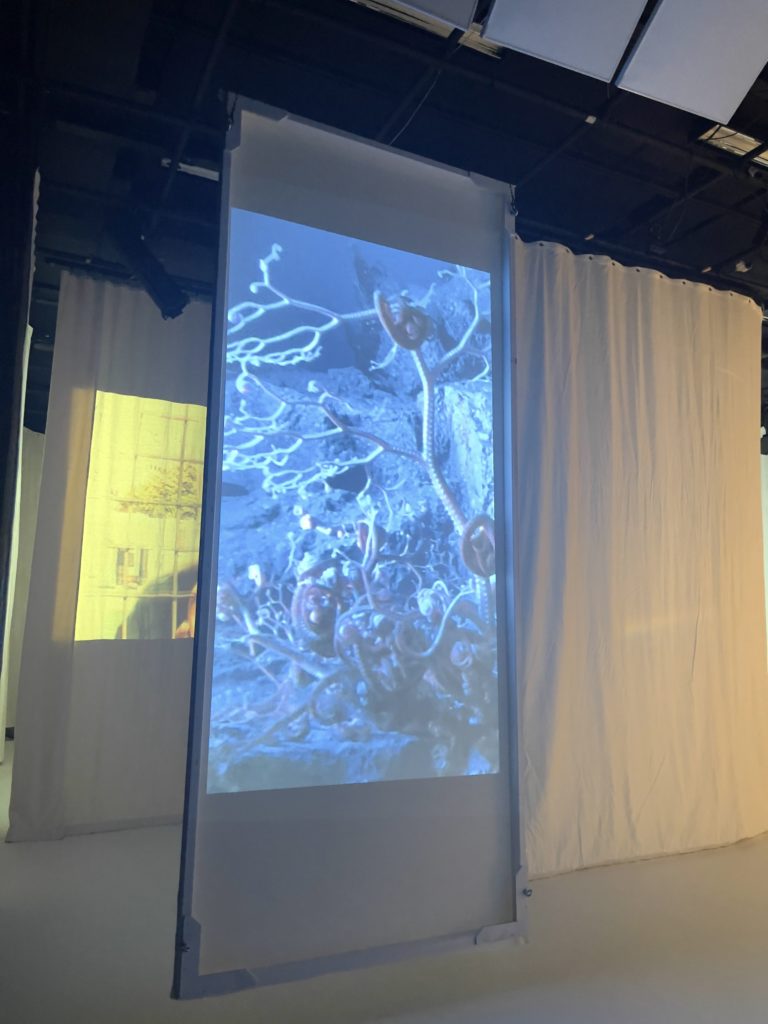Directional Sound in Exhibition ”how are we still alive here what about there”
Testimonial written as a courtesy to Panphonics by Markus Heino – Sound Designer
—
“I’ve used Panphonics speakers in my previous projects and learned about their unique features that way. The decision to use the same technology in this new project was actually easy because of these previous experiences.
In this project, the main goal was to create confined audio zones with as little leakage as possible in a fairly small and echoing space. We didn’t even consider using headphones because they would have been tricky and partially conflicted with the concept. The piece had two parts: an installation that was open during the day and the performances in the evenings, and we wanted to use the same technology in both.
Once the speakers arrived, the construction of the space was already long underway. We ended up having three audio zones, and in the installation, we used them to play the audio tracks of the videos and in the performance they were part of the audience area.
We built speaker groups that each had 3 passive speakers of the size 60×60 cm, with cables going all the way to the control room. We got all cables delivered together with other equipment and all the technical stuff worked perfectly.
Once the speakers had been set up, we made our first observations about the visual clarity of the elements and their suitability to the rest of the installation; the flat shape and the white colour felt just right. We were finally able to start with the sound testing and it also went really well: we were immediately able to accomplish what we wanted, which was keeping the audio zones separate, and we were able to carefully adjust the size and direction of the area by redirecting the elements, and acoustic reflections to other parts of the room were minimal. On top of this, the whole adjustment process was extremely fast, whereas if we had used cone speakers, the same effect would have been extremely difficult to accomplish.

On the top right corner the speakers are placed above the art piece. The product used was Sound Shower Passive 60x60cm in white colour
The user experience with the speakers had an immediate impact on the artistic content and its development, as well. Because the sound of human speech, in particular, was astonishingly clear, we were able to lower the general volume so that the content that we had planned was in the near sound field of the audience; the impression was almost like if you were wearing headphones, like you were in a ball full of sound. In the installation, it was as if the dialogue came from somewhere really close, and the speaker element disappeared acoustically, which was what we were going for.
The effect was so powerful that we could highlight the piece’s theme of loneliness and isolation in a way that wouldn’t have otherwise been possible.
The artistic premise of the piece was isolation from people due to the Covid pandemic, and thanks to the technical solutions offered by Panphonics, this idea was realised in phenomenal accuracy.
We were able to use the speakers not only in the installation mode of the piece but also in the performance mode, where we also used a conventional PA that was built as a cluster supported by a subwoofer with 360-degree audio. The Panphonics system surprised us with its usability combined this way with a conventional PA: their ability to play transients very accurately gave a razor-sharp edge to the soundscape and made it three-dimensional with such precision that is usually impossible in a concrete-walled studio space.
The whole Panphonics user experience was absolutely wonderful. All the technical goals of our plan were easily met. One feature that I hadn’t tried out before was using the speakers together with conventional ones, which led to a surprising range of new possibilities in artistic sound design and content creation, too.”